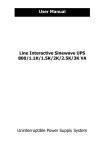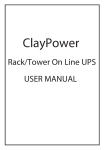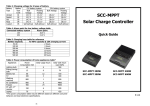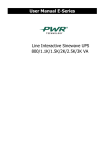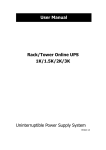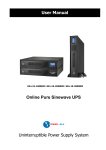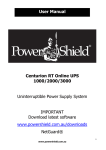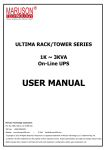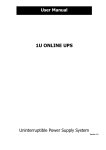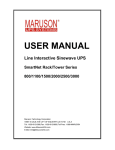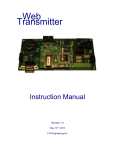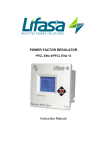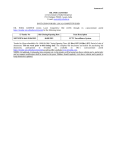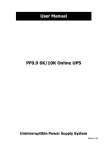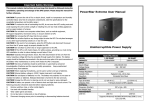Download Online RT/RTX User Manual Online UPS 1K/1.5K/2K/3K
Transcript
Online RT/RTX User Manual Online UPS 1K/1.5K/2K/3K Table of Contents 1. Important Safety Warning............................................................................................1 1-1. Transportation .....................................................................................................1 1-2. Preparation..........................................................................................................1 1-3. Installation ..........................................................................................................1 1-4. Operation ............................................................................................................1 1-5. Maintenance, service and faults.............................................................................2 2. Installation and setup..................................................................................................3 2-1 Rear panel view ....................................................................................................3 2-2. Operating principle ...............................................................................................4 2-3. Install the UPS .....................................................................................................4 2-4. Setup the UPS .....................................................................................................6 2-5 Battery Replacement .............................................................................................8 2-6 Battery Kit Assembly (option) .................................................................................9 3. Operations ...............................................................................................................11 3-1. Button operation ................................................................................................11 3-2. LCD Panel..........................................................................................................12 3-3. Audible Alarm ....................................................................................................13 3-4. LCD display wordings index.................................................................................13 3-5. UPS Setting .......................................................................................................14 3-6. Operating Mode Description ................................................................................17 3-7. Faults Reference Code ........................................................................................18 3-8. Warning indicator...............................................................................................18 4. Troubleshooting ........................................................................................................19 5. Storage and Maintenance ..........................................................................................21 6. Specifications ...........................................................................................................22 1. Important Safety Warning Please comply with all warnings and operating instructions in this manual strictly. Save this manual properly and read carefully the following instructions before installing the unit. Do not operate this unit before reading through all safety information and operating instructions carefully 1-1. Transportation Please transport the UPS system only in the original package to protect against shock and impact. 1-2. Preparation Condensation may occur if the UPS system is moved directly from cold to warm environment. The UPS system must be absolutely dry before being installed. Please allow at least two hours for the UPS system to acclimate the environment. Do not install the UPS system near water or in moist environments. Do not install the UPS system where it would be exposed to direct sunlight or near heater. Do not block ventilation holes in the UPS housing. 1-3. Installation Do not connect appliances or devices which would overload the UPS system (e.g. laser printers) to the UPS output sockets. Place cables in such a way that no one can step on or trip over them. Do not connect domestic appliances such as hair dryers to UPS output sockets. The UPS can be operated by any individuals with no previous experience. The UPS can be operated in TN&TT power distribution. Connect the UPS system only to an earthed shockproof outlet which must be easily accessible and close to the UPS system. Please use only UL-tested, UL-marked mains cable (e.g. the mains cable of your computer) to connect the UPS system to the building wiring outlet (shockproof outlet). Please use only UL-tested, UL-marked power cables to connect the loads to the UPS system. When installing the equipment, it should ensure that the sum of the leakage current of the UPS and the connected devices does not exceed 3.5mA. 1-4. Operation Do not disconnect the mains cable on the UPS system or the building wiring outlet (shockproof socket outlet) during operations since this would cancel the protective earth of the UPS system and of all connected loads. The UPS system features its own, internal current source (batteries). The UPS output sockets or output terminals block may be electrically live even if the UPS system is not connected to the building wiring outlet. In order to fully disconnect the UPS system, first press the OFF/Enter button to disconnect the mains. Prevent no fluids or other foreign objects from inside of the UPS system. The EPO, RS-232 and USB circuits are an IEC 60950 safety extra low voltage (SELV) 1 circuit. This circuit must be separated from any hazardous voltage circuits by reinforced insulation. 1-5. Maintenance, service and faults The UPS system operates with hazardous voltages. Repairs may be carried out only by qualified maintenance personnel. Caution - risk of electric shock. Even after the unit is disconnected from the mains (building wiring outlet), components inside the UPS system are still connected to the battery and electrically live and dangerous. Before carrying out any kind of service and/or maintenance, disconnect the batteries and verify that no current is present and no hazardous voltage exists in the terminals of high capability capacitor such as BUS-capacitors. Only persons are adequately familiar with batteries and with the required precautionary measures may replace batteries and supervise operations. Unauthorized persons must be kept well away from the batteries. Caution - risk of electric shock. The battery circuit is not isolated from the input voltage. Hazardous voltages may occur between the battery terminals and the ground. Before touching, please verify that no voltage is present! When changing batteries, install the same number and same type of batteries. Do not attempt to dispose of batteries by burning them. This could cause battery explosion. Do not open or destroy batteries. Escaping electrolyte can cause injury to the skin and eyes. It may be toxic. Please replace the fuse only with the same type and amperage in order to avoid fire hazards. Do not dismantle the UPS system. A battery can present a risk of electrical shock and high short-circuit current. The following precautions should be observed when working on batteries: a) Remove watches, rings, or other metal objects b) Use tools with insulated handles. c) Wear rubber gloves and boots. d) Do not lay tools or metal parts on top of batteries. e) Disconnect charging source prior to connecting or disconnecting battery terminals. 2 2. Installation and setup NOTE: Before installation, please inspect the unit. Be sure that nothing inside the package is damaged. Please keep the original package in a safe place for future use. 2-1 Rear panel view 1K/1.5K 2K NEMA 3K NEMA 1. Programmable outlets: connect to non-critical loads. 2. Output receptacles: connect to mission-critical loads. 3. AC input 4. Input circuit breaker 5. Emergency power off function connector (EPO) 6. USB communication port 7. RS-232 communication port 8. SNMP intelligent slot 9. External battery connector (only available for X models) 10. Output circuit breaker 3 2-2. Operating principle The operating principle of the UPS is shown as below The UPS is composed of mains input, TVSS and EMI/RFI filters, rectifier/PFC, inverter, battery charger, DC-to-DC converter, battery, dynamic bypass and UPS output. 2-3. Install the UPS For safety consideration, the UPS is shipped out from factory without connecting battery wires. Before install the UPS, please follow below steps to re-connect battery wires first. Step 1 Step 2 Step 3 Remove front panel. Connect the AC input and re-connect battery wires. Put the front panel back to the unit. This UPS can be either displayed on the desk or mounted in the 19” rack chassis. Please choose proper installation to position this UPS. Rack-mount Installation Install UPS alone 4 Install UPS and external battery Tower Installation Install UPS alone Step 1 Step 2 Step 3 Install UPS and external battery NOTE: When installing the UPS or battery pack with feet, please keep 70mm distance from the edge of the unit. 5 2-4. Setup the UPS Step 1: External battery connection (for X models only) Connect one end of external battery cable to UPS unit and the other end to battery pack. See below chart for detailed connection. Step 2: UPS input connection Plug the UPS into a two-pole, three-wire, grounded receptacle only. Avoid using extension cords. CAUTION: Please also install a UL-approved circuit breaker (40A) between the mains and AC input in 3K model for safety operation. Step 3: UPS output connection There two kinds of outputs: programmable outlets and general outlets. Please connect non-critical devices to the programmable outlets and critical devices to the general outlets. During power failure, you may extend the backup time to critical devices by setting shorter backup time for non-critical devices. Step 4: Communication connection Communication port: USB port RS-232 port Intelligent slot 6 To allow for unattended UPS shutdown/start-up and status monitoring, connect the communication cable one end to the USB/RS-232 port and the other to the communication port of your PC. With the monitoring software installed, you can schedule UPS shutdown/start-up and monitor UPS status through PC. The UPS is equipped with intelligent slot perfect for either SNMP or AS400 card. When installing either SNMP or AS400 card in the UPS, it will provide advanced communication and monitoring options. PS. USB port and RS-232 port can’t work at the same time. Step 5: Network connection Network/Fax/Phone surge port Connect a single modem/phone/fax line into surge-protected “IN” outlet on the back panel of the UPS unit. Connect from “OUT” outlet to the equipment with another modem/fax/phone line cable. Step 6: Disable and enable EPO function Keep the pin 1 and pin 2 closed for UPS normal operation. To activate EPO function, cut the wire between pin 1 and pin 2. It’s in closed status for UPS normal operation Step 7: Turn on the UPS Press the ON/Mute button on the front panel for two seconds to power on the UPS. Note: The battery charges fully during the first five hours of normal operation. Do not expect full battery run capability during this initial charge period. Step 8: Install software For optimal computer system protection, install UPS monitoring software to fully configure UPS shutdown. Please follow steps below to download and install monitoring software: 1. Go to the website http://www.power-software-download.com 2. Click ViewPower software icon and then choose your required OS to download the software. 3. Follow the on-screen instructions to install the software. 4. When your computer restarts, the monitoring software will appear as an orange plug icon located in the system tray, near the clock. 7 2-5 Battery Replacement NOTICE: This UPS is equipped with internal batteries and user can replace the batteries without shutting down the UPS or connected loads.(hot-swappable battery design) Replacement is a safe procedure, isolated from electrical hazards. CAUTION!! Consider all warnings, cautions, and notes before replacing batteries. Note: Upon battery disconnection, equipment is not protected from power outages. Step 1 Step 2 Step 3 Remove front panel. Disconnect battery wires. Step 4 Step 5 Pull out the battery box by removing two screws on the front panel. Step 6 Remove the top cover of battery box and replace the inside batteries. After replacing the Re-connect the battery wires. batteries, put the battery box back to original location and screw it tightly. Step 7 Put the front panel back to the unit. 8 2-6 Battery Kit Assembly (option) NOTICE: Please assemble battery kit first before installing it inside of UPS. Please select correct battery kit procedure below to assemble it. 2-battery kit Step 1: Remove adhesive tapes. Step 2: Connect all battery terminals by following below chart. Tapes Step 3: Put assembled battery packs on one side of plastic shells. 3-battery kit Step 1: Remove adhesive tapes. Step 4: Cover the other side of plastic shell as below chart. Then, battery kit is assembly well. Step 2: Connect all battery terminals by following below chart. Tapes Tapes Step 3: Put assembled battery packs on one side of plastic shells and insert one more defect battery on the space. Step 4: Cover the other side of plastic shell as below chart. Then, battery kit is assembly well. Defect battery 9 4-battery kit Step 1: Remove adhesive tapes. Step 2: Connect all battery terminals by following below chart. Tapes Tapes Step 3: Put assembled battery packs on one side of plastic shells. 6-battery kit Step 1: Remove adhesive tapes. Step 4: Cover the other side of plastic shell as below chart. Then, battery kit is assembly well. Step 2: Connect all battery terminals by following below chart. Tapes Tapes Step 3: Put assembled battery packs on one side of plastic shells. Step 4: Cover the other side of plastic shell as below chart. Then, battery kit is assembly well. 10 3. Operations 3-1. Button operation Button View Button ON/Mute Button OFF/Enter Button Select Button ON/Mute + Select Button Function Turn on the UPS: Press and hold ON/Mute button for at least 2 seconds to turn on the UPS. Mute the alarm: After the UPS is turned on in battery mode, press and hold this button for at least 5 seconds to disable or enable the alarm system. But it’s not applied to the situations when warnings or errors occur. Up key: Press this button to display previous selection in UPS setting mode. Switch to UPS self-test mode: Press ON/Mute buttons simultaneously for 5 seconds to enter UPS self-testing while in AC mode, ECO mode, AECO mode, or converter mode. Turn off the UPS: Press and hold this button at least 2 seconds to turn off the UPS in battery mode. UPS will be in standby mode under power normal or transfer to bypass mode if the Bypass enable setting by pressing this button. Confirm selection key: Press this button to confirm selection in UPS setting mode. Switch LCD message: Press this button to change the LCD message for input voltage, input frequency, battery voltage, output voltage, output frequency. Setting mode: Press and hold this button for 5 seconds to enter UPS setting mode when Standby and Bypass mode. Down key: Press this button to display next selection in UPS setting mode. Switch to bypass mode: When the main power is normal, press ON/Mute and Select buttons simultaneously for 5 seconds. Then UPS will enter to bypass mode. This action will be ineffective when the input voltage is out of acceptable range. 11 3-2. LCD Panel Display Function Remaining backup time information Indicates the remaining backup time in pie chart. Indicates the remaining backup time in numbers. H: hours, M: minute, S: second Fault information Indicates that the warning and fault occurs. Indicates the warning and fault codes, and the codes are listed in details in 3-5 section. Mute operation Indicates that the UPS alarm is disabled. Output & Battery voltage information Indicates the output voltage, frequency or battery voltage. Vac: output voltage, Vdc: battery voltage, Hz: frequency Load information Indicates the load level by 0-25%, 26-50%, 51-75%, and 76-100%. Indicates overload. Indicates the load or the UPS output is short circuit. Mode operation information Indicates the UPS connects to the mains. Indicates the battery is working. Indicates the bypass circuit is working. Indicates the ECO mode is enabled. Indicates the Inverter circuit is working. Indicates the output is working. Programmable outlets information Indicates that programmable outlets have output voltage. Battery information 12 Indicates the Battery level by 0-25%, 26-50%, 51-75%, and 76-100%. Indicates the battery is fault. Indicates low battery level and low battery voltage. Input & Battery voltage information Indicates the input voltage or frequency or battery voltage. Vac: Input voltage, Vdc: battery voltage, Hz: input frequency 3-3. Audible Alarm Battery Mode Low Battery Overload Fault Sounding every 4 seconds Sounding every second Sounding twice every second Continuously sounding 3-4. LCD display wordings index Abbreviation Display content Meaning ENA Enable DIS Disable ESC Escape HLS High loss LLS Low loss BAT Battery CF Converter TP Temperature CH Charger SF Site Fault EP EPO FU Bypass frequency unstable EE EEPROM error 13 3-5. UPS Setting There are three parameters to set up the UPS. Parameter 1: It’s for program alternatives. Refer to below table. Parameter 2 and parameter 3 are the setting options or values for each program. 01: Output voltage setting Interface Setting For 200/208/220/230/240 VAC models, you may choose the following output voltage: 200: presents output voltage is 200Vac 208: presents output voltage is 208Vac 220: presents output voltage is 220Vac 230: presents output voltage is 230Vac 240: presents output voltage is 240Vac For 100/110/115/120VAC models, you may choose the following output voltage: 100: presents output voltage is 100Vac 110: presents output voltage is 110Vac 115: presents output voltage is 115Vac 120: presents output voltage is 120Vac 02: Frequency Converter enable/disable Interface Setting CF ENA: converter mode enable CF DIS: converter mode disable(Default) 03: Output frequency setting Interface Setting You may set the initial frequency on battery mode: BAT 50: presents output frequency is 50Hz BAT 60: presents output frequency is 60Hz If converter mode enable, you may choose the following output frequency: CF 50: presents output frequency is 50Hz CF 60: presents output frequency is 60Hz 14 04: ECO enable/disable Interface 05: AECO enable/disable Interface Setting ENA: ECO mode enable DIS: ECO mode disable(Default) Setting ENA: Advanced ECO mode enable DIS: Advanced ECO mode disable(Default) 06: Bypass mode enable/disable when UPS is off Interface Setting ENA: Bypass mode is enabled when UPS is off DIS: Bypass mode is disabled when UPS is off (Default) 07: Programmable outlets enable/disable Interface Setting ENA: Programmable outlets enable DIS: Programmable outlets disable(Default) 08: Programmable outlets setting Interface Setting 0-999: setting the backup time limits in minutes from 0-999 for programmable outlets which connect to non-critical devices on battery mode. 15 09: Acceptable input voltage range setting Interface Setting For 200/208/220/230/240 VAC models, you may choose the following selection for acceptable input voltage range: 110/300 flashing in turns: The acceptable input voltage range is from 110V to 300V. 160/260 flashing in turns: The acceptable input voltage range is from 160V to 260V. 170/270 flashing in turns: The acceptable input voltage range is from 170V to 270V. For 100/110/115/120 VAC models, you may choose the following selection for acceptable input voltage range: 55/150 flashing in turns: The acceptable input voltage range is from 55V to 150V. 80/130 flashing in turns: The acceptable input voltage range is from 80V to 130V. 85/135 flashing in turns: The acceptable input voltage range is from 85V to 135V. 00: Exit setting 16 3-6. Operating Mode Description Operating Description mode Online mode When the input voltage is within acceptable range, UPS will provide pure and stable AC power to output. The UPS will also charge the battery at online mode. ECO mode (Efficiency Corrective Optimizer) When the input voltage is within setting range (±3%Vo max), UPS will bypass voltage to output for energy saving. PFC and INVERTER are still active at this mode. AECO mode (Advanced Efficiency Corrective Optimizer) When the input voltage is within setting range (±3%Vo max), UPS will bypass voltage to output for energy saving. PFC and INVERTER are off at this mode. Frequency Converter mode (Rack) When input frequency is within 40 Hz to 70 Hz, the UPS can be set at a constant output frequency, 50 Hz or 60 Hz. The UPS will still charge battery under this mode. Battery mode When the input voltage is beyond the acceptable range or power failure and alarm is sounding every 4 second, UPS will backup power from battery. Bypass mode When input voltage is within acceptable range but UPS is overload, UPS will enter bypass mode or bypass mode can be set by front panel. Alarm is sounding every 10 second. 17 LCD display Standby mode UPS is powered off without output power, but the battery still can be charged. Fault mode The UPS is in fault mode when no output power is supplied from the UPS and the fault icon flashes on the LCD display, although the information of UPS can be displayed in the screen. 3-7. Faults Reference Code Fault event Fault code Bus start fail 01 Bus over 02 Bus under 03 Bus unbalance 04 Bus short circuited 05 Inverter soft start fail 11 Inverter voltage high 12 3-8. Warning indicator Warning Low Battery Icon x x x x x x x Fault event Inverter voltage Low Inverter output short Battery voltage too high Battery voltage too low Over temperature Over load Icon (flashing) Fault code 13 14 27 28 41 43 Alarm Sounding every second Sounding twice every second Overload Battery is not connected Over Charge Site Fault EPO enable Over temperature Charger failure Battery fault Out of bypass voltage range Bypass frequency unstable EEPROM error Sounding Sounding Sounding Sounding Sounding Sounding Sounding Sounding Sounding Sounding 18 every every every every every every every every every every second second second second second second second second second second Icon x x 4. Troubleshooting If the UPS system does not operate correctly, please solve the problem by using the table below. Symptom Possible cause Remedy No indication and alarm even The AC input power is not Check if input power cord though the main is normal. connected well. firmly connected to the mains. The AC input is connected Plug AC input power cord to to the UPS output. AC input correctly. The icon is flashing and the warning code is lighting on LCD display. Alarm is sounding every second. EPO function is activated. The icon is flashing and is lighting on LCD display. Alarm is sounding every second. Line and neutral conductors Rotate mains power socket of UPS input are reversed. by 180° and then connect to UPS system. The icon and flashing on LCD display and alarm is sounding every second. Fault code is shown as 27 and the The external or internal battery is incorrectly connected. icon is lighting on LCD display and alarm is continuously sounding. Fault code is shown as 28 and the icon is lighting on LCD display and alarm is continuously sounding. The icon and is flashing on LCD display and alarm is sounding twice every second. Set the circuit in closed position to disable EPO function. Check if all batteries are connected well. Battery voltage is too high Contact your dealer. or the charger is fault. Battery voltage is too low or Contact your dealer. the charger is fault. UPS is overload UPS is overloaded. Devices connected to the UPS are fed directly by the electrical network via the Bypass. After repetitive overloads, the UPS is locked in the Bypass mode. Connected devices are fed directly by the mains. 19 Remove excess loads from UPS output. Remove excess loads from UPS output. Remove excess loads from UPS output first. Then shut down the UPS and restart it. Symptom Possible cause Remedy Remove excess loads from Fault code is shown as 43 and The The UPS shut down automatically because of UPS output and restart it. is lighting on LCD icon overload at the UPS output. display and alarm is continuously sounding. Fault code is shown as 14 and the icon is lighting on LCD display. Alarm is continuously sounding. Fault code is shown as 01, 02, 03, 04, 11, 12, 13 and 41 on LCD display and alarm is continuously sounding. The UPS shut down Check output wiring and if automatically because short connected devices are in circuit occurs on the UPS short circuit status. output. A UPS internal fault has Contact your dealer occurred. There are two possible results: 1. The load is still supplied, but directly from AC power via bypass. 2. The load is no longer supplied by power. Battery backup time is shorter than Batteries are not fully Charge the batteries for at nominal value charged least 5 hours and then check capacity. If the problem still persists, consult your dealer. Batteries defect Contact your dealer to replace the battery. Fault code is shown as 05 on LCD display. At the same time, alarm is continuously sounding and output is cut off. A UPS internal fault has Consult your dealer. If the occurred and BUS is short UPS power is on again circuited. before repair, the DC/DC mosfet will damage. 20 5. Storage and Maintenance Operation The UPS system contains no user-serviceable parts. If the battery service life (3~5 years at 25°C ambient temperature) has been exceeded, the batteries must be replaced. In this case, please contact your dealer. Be sure to deliver the spent battery to a recycling facility or ship it to your dealer in the replacement battery packing material. Storage Before storing, charge the UPS 5 hours. Store the UPS covered and upright in a cool, dry location. During storage, recharge the battery in accordance with the following table: Storage Temperature Recharge Frequency Charging Duration -25°C - 40°C Every 3 months 1-2 hours 40°C - 45°C Every 2 months 1-2 hours 21 6. Specifications MODEL Capacity VA W DC1000RT DC1000RTX DC1500RT DC1500RTX DC2000RT DC2000RTX DC3000RT DC3000RTX 1000 VA 800 W 1000 VA 800W 1500 VA 1200 W 1500 VA 1200 W 2000 VA 1600 W 2000 VA 1600 W 3000 VA 2400 W 3000 VA 2400 W INPUT Rated voltage Low Line Transfer Voltage Low Line Range Comeback High Line Transfer High Line Comeback Frequency Range Power Factor OUTPUT Output Voltage AC Voltage Regulation Frequency Range Frequency Range Current Crest Ratio (CF) Harmonic Distortion (THDU) 100VAC-120VAC 80 VAC/70 VAC/60 VAC/55 VAC ± 5 % (based on load percentage 100%-80% / 80%-70% / 70%-60% / 60%-0) 85 VAC/75 VAC/65 VAC/60 VAC ± 5 % 150 VAC ± 5 % 142 VAC ± 5 % 40Hz ~ 70Hz ≧0.99 @normal voltage 100*/110*/115*/120VAC ± 1% 47 ~ 53 Hz or 57 ~ 63 Hz (Synchronized Range) 50Hz 0.5% or 60Hz 0.5% (Bat. Mode) 5:1 (max.) ≦ 2% (Linear load) ≦ 2% (Linear load) 8% max (Batt. mode before shut down) 8% max (Batt. mode before shut down) Zero AC to DC Inverter to 4 ms (Typical) Bypass Waveform (Batt. Mode) Pure Sine wave EFFICIENCY AC Mode 86% (typical), 88% (peak) 88% (typical), 90% (peak) Battery Mode 83% (typical), 86% (peak) 85% (typical), 88% (peak) BATTERY Battery Type 12V/9Ah 12V/9Ah 12V/9Ah 12V/9Ah Numbers 2 3 4 6 Typical Recharge Time 4 hours recover to 90% capacity (for standard model only) Charging Current (max.) 1A 1A 1A 1A Charging Voltage 27.4 VDC ± 1% 41.1 VDC ± 1% 54.7 VDC ± 1% 82.1VDC ± 1% INDICATORS LCD UPS status, Load level, Battery level, Input/Output/battery info, Discharge time and Fault indicators ALARM Battery Mode Sounding every 4 seconds Low Battery Sounding every second Overload Sounding twice every second Fault Continuously sounding PHYSICAL Dimension, DxWxH (mm) 380 x 438 x 88 480 x 438 x 88 480 x 438 x 88 600 x 438 x 88 Net Weight (kgs) 13.2 18.9 21.4 29.6 ENVIRONMENT Humidity 20-90 % RH @ 0- 40°C (non-condensing) Noise Level Less than 50dBA @ 1 Meter MANAGEMENT Smart RS-232/USB Supports Windows 2000/2003/XP/Vista/2008/7, Linux, Unix, and MAC Optional SNMP Power management from SNMP manager and web browser *Derate capacity to 95% when the output voltage is adjusted to 115VAC, derate capacity to 90% when the output voltage is adjusted to 110VAC and derate capacity to 80% when the output voltage is adjusted to 100VAC. Transfer Time 22 Battery Pack Specification Model Used with UPS Models Battery Type Battery Numbers DC1000RTXEBM DC1500RTXEBM DC2000RTXEBM DC3000RTXEBM 1K 1.5K 2K 3K 12V 9Ah 12V 9Ah 12V 9Ah 12V 9Ah 4 6 8 12 480 x 438 x 88 600 x 438 x 88 29 41.2 Dimensions(DxWxH) Net Weight(kgs) 380 x 438 x 88 17.1 21.5 NOTE: Battery pack should be used with corresponded UPS. Orion Power Systems Service and Technical Support If you have any problems or questions with the UPS, call your local distributor or Orion Power Systems technical support at the following telephone number : In the United States: 1-877-385-1654 Please have the following information ready when you call: - Model number and Serial number - Description of failure or problem - Date of failure or problem - Customer contact information and return address If repair is necessary, you will be given a Returned Material Authorization (RMA) number. The RMA number must appear on the outside of the box and on the Bill Of Lading. Original packaging should be used if available. Systems that get damaged in transit as a result of improper packaging are not covered under warranty. A replacement or repair unit will be shipped, freight prepaid for all units under warranty. NOTE: For critical applications, immediate replacement may be available. 23

























